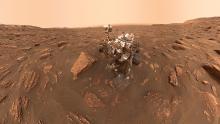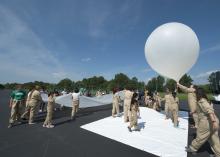Distric of Columbia Public Schools
Welcome to the Holt Scholars Program Page for DC Public Schools!
The Holt Scholars Program was established in 2014 by a generous donation from the Hillside Foundation to focus on educational outreach to DC Public School students, their families, and local teachers. In addition to sponsoring museum visits, the Holt Scholars Program also provides opportunities for teacher professional development and family engagement events.
The Holt Scholars Program provides a DCPS district-approved, NGSS-aligned Cornerstone Field Trip experience to the National Air and Space Museum during Quarter 1 for all 6th grade DCPS students as part of the Smithsonian’s DC Metro Initiative. Unique student experiences for 6th graders are also available each Quarter; please review all program options below and contact NASMFieldTrips@si.edu for next steps on requesting a student experience.
Student Experience Overview
What are some of the skills and challenges facing engineers building spacecraft designed for Mars exploration? During this Cornerstone, students will learn about different types of spacecraft, look closely at models of actual Mars spacecraft either virtually or online, and then participate in a post visit activity to either determine the identify of a “mystery spacecraft” or to work in a small team to design a rover on Tinkercad.
Holt Scholars Museum coordinated on-site field trips to the Museum in DC will not take place until January 2023. Groups are welcome to visit as a self-guided group. Holt Scholars Museum coordinated on-site field trips to the Museum in DC will take place on Wednesdays and Fridays during the school year. To request a field trip, please email NASMFieldTrips@si.edu . To participate in virtual activities or find digital resources, please visit the Cornerstone Learning Lab page.
What can we learn about a planet by studying its surface? Students will travel through space to explore major features on Earth and Mars such as the Grand Canyon, Valles Marineris, Emi Koussi Shield Volcano, Olympus Mons, and the Yukon-Kuskokwim Delta to learn more about the geologic processes that alter the face of different planets. What does learning about the impact of geoscience processes on Mars teach us about Earth? Students will participate in a hands-on demonstration, a planetarium show, and use a self-led Museum Exploration guide to learn more about the objects on display in the new exhibits.
How can the interactions of the air, ocean and land be used to predict the movement of balloons? During this outreach opportunity students will create prediction maps for high-altitude balloons, launch the balloons, and track them online to compare the balloon’s actual versus predicted trajectory.
How do we track human activity and impact from Space? Journey with us to discover information given to us from satellites about our planet. Students will participate in a pilot Engineering & Design Challenge, a planetarium show, and use a self-led Museum Exploration guide to learn more about the objects on display in the new exhibits.



